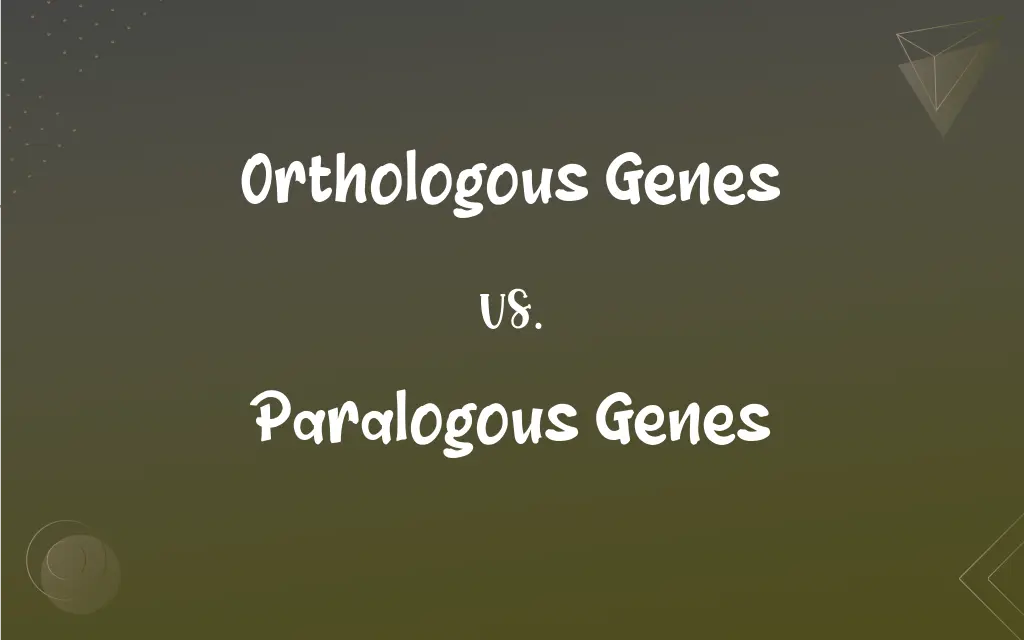Orthologous Genes vs. Paralogous Genes: What's the Difference?
Edited by Janet White || By Harlon Moss || Published on February 15, 2024
Orthologous genes are homologous genes in different species that evolved from a common ancestral gene, while paralogous genes are homologous genes within the same species that evolved by gene duplication.

Key Differences
Orthologous genes are found in different species but share a common ancestor, indicating a speciation event. Paralogous genes arise within the same species from gene duplication, leading to gene families.
Orthologous genes often retain similar functions across different species, reflecting evolutionary conservation. Paralogous genes can evolve new functions, contributing to genetic diversity within a species.
Studying orthologous genes helps in understanding evolutionary relationships between species. Analysis of paralogous genes provides insights into the mechanisms of gene evolution and diversification.
Orthologous genes are key in comparative genomics and phylogenetics. Paralogous genes play a significant role in the study of genome complexity and adaptation.
Orthologous genes are used as molecular markers in evolutionary biology. Paralogous genes, by diversifying gene function, contribute to the adaptability and evolution of organisms.
ADVERTISEMENT
Comparison Chart
Origin
From a common ancestral gene in different species
From gene duplication within the same species
Function
Often retain similar functions across species
Can evolve new functions within a species
Role in Evolution
Indicate speciation events
Contribute to genetic diversity and complexity
Usage in Studies
Important in comparative genomics and phylogenetics
Crucial for understanding gene evolution and diversification
Contribution to Biology
Serve as molecular markers in evolutionary biology
Enhance adaptability and evolution within species
ADVERTISEMENT
Orthologous Genes and Paralogous Genes Definitions
Orthologous Genes
Orthologous genes often retain similar functions across species.
Orthologous genes in fish and amphibians show similar developmental roles.
Paralogous Genes
Paralogous genes are homologous genes within the same species from gene duplication.
The hemoglobin gene family in humans is an example of paralogous genes.
Orthologous Genes
They indicate evolutionary relationships between species.
Studying orthologous genes helps trace the evolutionary lineage of mammals.
Paralogous Genes
Contribute to genetic diversity and complexity.
Gene duplication and the resulting paralogous genes increase genetic variability.
Orthologous Genes
Orthologous genes are homologous genes in different species from a common ancestor.
The p53 gene is an orthologous gene conserved in humans and mice.
Paralogous Genes
They can evolve new functions within a species.
Paralogous genes in plants have led to diverse metabolic pathways.
Orthologous Genes
Key in understanding speciation and evolutionary conservation.
Orthologous genes provide insights into the divergence of species from common ancestors.
Paralogous Genes
Important for studying gene evolution and diversification.
Paralogous genes in yeast are key to understanding its adaptive mechanisms.
Orthologous Genes
Used as molecular markers in evolutionary studies.
Researchers use orthologous genes to construct phylogenetic trees.
Paralogous Genes
Enhance adaptability and evolution within species.
Paralogous genes in bacteria facilitate rapid adaptation to new environments.
FAQs
What are paralogous genes?
Homologous genes within the same species that evolved by gene duplication.
What are orthologous genes?
Homologous genes in different species from a common ancestor.
Can paralogous genes evolve new functions?
Yes, they can evolve new functions within a species.
Why are orthologous genes important in evolutionary studies?
They help trace evolutionary relationships and speciation events.
What role do paralogous genes play in genetics?
They contribute to genetic diversity and complexity.
How do paralogous genes affect an organism's adaptability?
They provide genetic variability for adaptation and evolution.
What leads to the formation of paralogous genes?
Gene duplication within the same species.
Do orthologous genes have similar functions?
Yes, they often retain similar functions across species.
How do orthologous genes arise?
Through speciation from a common ancestral gene.
How do orthologous genes differ in different species?
They may have minor variations but generally conserve function.
What is an example of orthologous genes?
The gene for cytochrome c in humans and yeast.
Give an example of paralogous genes.
The alpha and beta hemoglobin genes in humans.
Can orthologous genes indicate evolutionary distance?
Yes, they are used to estimate evolutionary distances between species.
Are orthologous genes used in phylogenetic tree construction?
Yes, they are essential for constructing phylogenetic trees.
How do paralogous genes contribute to evolutionary biology?
They highlight the mechanisms of gene evolution and diversity.
Are paralogous genes always functionally different?
Not always, but they often diverge functionally over time.
How are orthologous genes identified?
Through comparative genomics and phylogenetic analysis.
Do orthologous genes help in drug discovery?
Yes, by understanding conserved pathways across species.
Can paralogous genes lead to diseases?
Yes, if their diverged functions disrupt normal cellular processes.
What is the significance of gene duplication in paralogous genes?
It's a major source of new genes and genetic innovation.
About Author
Written by
Harlon MossHarlon is a seasoned quality moderator and accomplished content writer for Difference Wiki. An alumnus of the prestigious University of California, he earned his degree in Computer Science. Leveraging his academic background, Harlon brings a meticulous and informed perspective to his work, ensuring content accuracy and excellence.
Edited by
Janet WhiteJanet White has been an esteemed writer and blogger for Difference Wiki. Holding a Master's degree in Science and Medical Journalism from the prestigious Boston University, she has consistently demonstrated her expertise and passion for her field. When she's not immersed in her work, Janet relishes her time exercising, delving into a good book, and cherishing moments with friends and family.







































































